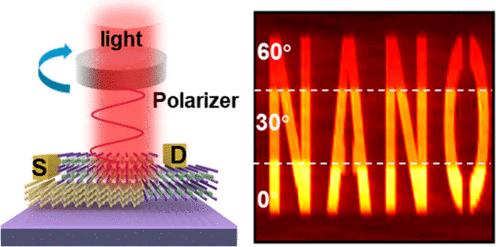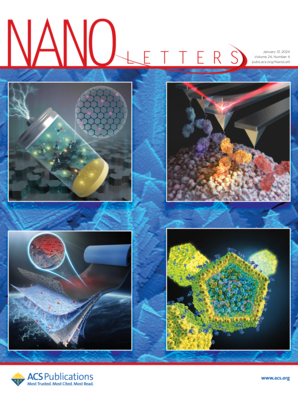IF 9.6
1区 材料科学
Q1 CHEMISTRY, MULTIDISCIPLINARY
引用次数: 0
摘要
偏振成像和加密提高了目标识别精度和信息安全性,增强了图像传感器的感知敏锐度和抗干扰能力。然而,由于偏振片等色散光学元件的复杂集成,传感系统的微型化面临挑战。为此,我们提出了一种使用 Te/ReSe2 范德瓦尔斯异质结构的偏振敏感光电探测器。这种设计利用 II 型带对准实现了高效的光载流子分离。ReSe2 和 Te 层的各向异性晶体取向将光子吸收与光电载流子提取结合在一起,从而增强了功能。Te/ReSe2 器件具有宽光谱光响应(300-965 nm)、8.9 的高偏振比以及在 635 nm 波长下 55.4/55.7 μs 的快速响应时间。这些特性使得高分辨率偏振成像和精确图像处理成为可能。这项研究为开发微型偏振敏感光电探测器和推进无透镜偏振光电子学的发展提供了蓝图。本文章由计算机程序翻译,如有差异,请以英文原文为准。

Lensless Polarimetric Imaging and Encryption Enabled by Te/ReSe2 van der Waals Heterostructure Polarization-Sensitive Photodetector
Polarimetric imaging and encryption improve target recognition precision and information security, enhancing image sensors’ perceptual acuity and interference resilience. However, the miniaturization of sensing systems faces challenges due to the complex integration of dispersive optical components such as polarizers. To address this, we propose a polarization-sensitive photodetector using a Te/ReSe2 van der Waals heterostructure. This design leverages type-II band alignment for efficient photocarrier segregation. The anisotropic crystal orientations of ReSe2 and Te layers integrate photon absorption with photocarrier extraction, boosting the functionality. The Te/ReSe2 device offers a broad spectral photoresponse (300–965 nm), a high polarization ratio of 8.9, and a fast response time of 55.4/55.7 μs at 635 nm. These properties enable high-resolution polarimetric imaging and precise image processing. This study provides a blueprint for developing miniaturized polarization-sensitive photodetectors and advancing lensless polarimetric optoelectronics.
求助全文
通过发布文献求助,成功后即可免费获取论文全文。
去求助
来源期刊

Nano Letters
工程技术-材料科学:综合
CiteScore
16.80
自引率
2.80%
发文量
1182
审稿时长
1.4 months
期刊介绍:
Nano Letters serves as a dynamic platform for promptly disseminating original results in fundamental, applied, and emerging research across all facets of nanoscience and nanotechnology. A pivotal criterion for inclusion within Nano Letters is the convergence of at least two different areas or disciplines, ensuring a rich interdisciplinary scope. The journal is dedicated to fostering exploration in diverse areas, including:
- Experimental and theoretical findings on physical, chemical, and biological phenomena at the nanoscale
- Synthesis, characterization, and processing of organic, inorganic, polymer, and hybrid nanomaterials through physical, chemical, and biological methodologies
- Modeling and simulation of synthetic, assembly, and interaction processes
- Realization of integrated nanostructures and nano-engineered devices exhibiting advanced performance
- Applications of nanoscale materials in living and environmental systems
Nano Letters is committed to advancing and showcasing groundbreaking research that intersects various domains, fostering innovation and collaboration in the ever-evolving field of nanoscience and nanotechnology.
 求助内容:
求助内容: 应助结果提醒方式:
应助结果提醒方式:


